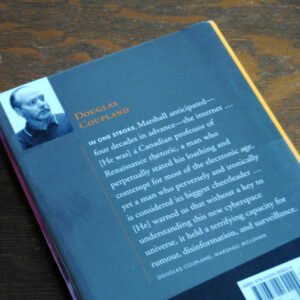
On at least three different occasions, I have picked up my parents’ hand-me down paperback of Marshall McLuhan’s Understanding Media and I have not gotten past page nine or ten yet. So I was happy to get a biography of the man and a cliffnotes of his career from of one of my favorite contemporary authors, Douglas Coupland.
Coupland was selected to write about Marshall McLuhan for the series Extraordinary Canadians. Now that I know more about McLuhan, at least more than I knew from friend Professor Sara Netzley and my parents, I now see the wisdom of series editor John Ralston Saul in pairing him with Coupland.
In his introduction, Saul writes, “Douglas Coupland is not just a wonderful novelist and artist. He is in and of himself the contemporary expression of McLuhan’s theories, the natural child of McLuhanism, and therefore the perfect biographer for the man who broke the shackles of linear communications.” After completing the book, I can agree, since I went into this one knowing more about the author than the subject. That’s something that doesn’t happen all that often.
To be honest, Coupland is one of those authors who’s always pushing the artistic limits of any medium he touches, biography included. Coupland does his best to teach us something about McLuhan, but you can’t stop him as an artist from having a little fun with the medium. After all, the biography starts off with a page dedicated to “names” for his subject by “placing the name Marshall McLuhan into commonly available internet name generators.”
It doesn’t stop there. The footnotes in this book are as entracing as the larger texts on the pages. Don’t skip those if you pick this up, because they’re just the tip of the artistic iceberg here.
Coupland includes seller’s notes from an abebooks.com listings of McLuhan’s work including some comment threads from other site users. A thread from a YouTube video titled “McLuhan on YouTube” also appears in the printed pages of this book.
A “natural child of McLuhanism,” indeed!
Above everything, I learned that I really like McLuhan as a person. And while I haven’t actually read his books, I plan to give it a more earnest try, because I have a podcast dedicated to conversation. In reading about McLuhan, I can say that my podcast is dedicated to holding onto to our oral histories and person-to-person audio communication.
 Coupland bails me out by writing that “getting into Marshall is, for most people, like visiting Antarctica. You have to have time, patience, endurance, means, and stubbornness to do so, and once you’re there, you’re unsure of just what it is you will find.”
Coupland bails me out by writing that “getting into Marshall is, for most people, like visiting Antarctica. You have to have time, patience, endurance, means, and stubbornness to do so, and once you’re there, you’re unsure of just what it is you will find.”
Before this book, I was aware that McLuhan can’t be whittled down to fortune cookie wisdom. There’s a lot more to “the medium is the message” and “the global village” than just those summarized blurbs, but of the selected lines Coupland chose to include throughout the book, I have a list of five that spoke the most to me, at this time and place in my life.
- When you give people too much information, they instantly resort to pattern recognition to structure the experience. The work of the artist is to find patterns. – M.M.
- A point of view can be a dangerous luxury when substituted for insight and understanding. – M.M.
- Art is anything you can get away with. – M.M.
- I don’t necessarily agree with everything I say. – M.M.
- Our “Age of Anxiety” is, in great part, the result of trying to do today’s job with yesterday’s tools–with yesterday’s concepts. – M.M.
That said, I’m very interested in how blurbs like these are prescribed to today and tomorrow. Most importantly, I think that quotes like, “I think of art, at its most significant, as a DEW Line, a Distant Early Warning system that can always be relied on to tell the old culture what is beginning to happen to it,” are more intriguing now because of the speed of art and technology, similar to watching a stormfront come through.
Then again, we haven’t figured out the weather all that well. Storms will often strengthen or dissipate moments after we see them on radar, so perhaps we still have a long way to go. But studying McLuhan, even or perhaps especially with the help of Coupland, may be the best place to start.